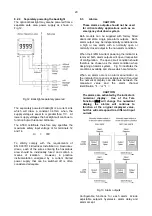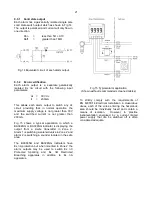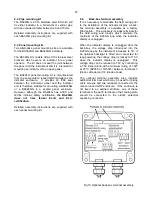
28
APPENDIX 1
A1.0 ATEX dust certification
In addition to ATEX certification permitting
installation in Zone 2 gas atmospheres which is
described in the main section of this instruction
manual, the BA304NG and the BA324NG also
have ATEX Ex tc certification, allowing installation
in Zone 22 combustible dust atmospheres.
A1.1
Zones and Maximum Surface
Temperature
The indicators have been certified as Group II
Category 3D Ex tc IIIC T80ºC Dc IP66 apparatus
with a Ta of –40ºC to +70C. This is dust ignition
protection by enclosure complying with
EN 60079-31.
When installed as specified in this instruction
manual and complying with the requirements of
EN 60079-14 the indicators may be installed in:
Zone 22
explosive atmosphere in the form of
a cloud of combustible dust in air is
not likely to occur in normal
operation, but if it does occur, will
only persist for a short period.
Be used with dusts having a Minimum Ignition
Temperature of:
Dust cloud
120°C
Dust layer on indicator
155
°
C
up to 5mm thick.
*
Dust layer on indicator
Refer to
over 5mm thick.
*
EN 60079-14
At an ambient temperature between -40 and +70°C
*
Unlikely occurrence in Zone 22
A1.2 Installation
All the circuits shown in the main section of this
manual for indicator installations in Zone 2
flammable gas atmosheres, may also be used for
Zone 22 combustible dust applications. The
indicator should be located where the minimum
amount of dust will accumulate on the enclosure
and the installation should be as specified in this
instruction manuals and comply with the
requirements of EN 60079-14
Electrical
installations design, selection and erection
EN 60079-14, requires that each of the wires
entering the hazardous area should be individually
fused and contain a means of isolation. However,
in practice instrumentation energised by a current
limited power supply that can be switched off is
often considered adequate.
A1.3 Maintenance
Ex tc protection does not permit live maintenance,
but the BA304NG and BA324NG indicators may be
calibrated in Zone 22 providing the instrument
enclosure is not opened.
ENSURE PLANT SAFETY BEFORE
STARTING MAINTENANCE
The indicator enclosure should only be
opened and live maintenance performed
when there is little risk of a combustible
dust being present. During maintenance
ensure that dust or water do not enter the
enclosure. Before replacing the
intrument assembly onto the back-box
ensure that the sealing gasket is
undamaged and free from dirt and
foreign bodies.
Inspection of
t
he indicator’s mechanical condition
and removal of accumulated dust from the outside
of the enclosure should be regularly performed.
The interval between inspections depends upon
environmental conditions. Removal of flammable
dust should be performed with care to avoid
creating a dust cloud.


































